Jewish Presence (1) -
Settlement
 note:
the Whitechapel Gallery, a fine Arts & Crafts building of 1901 designed by Charles Harrison Townsend, restored and extended in 2009, became a
focal point for Jewish intellectual life in the area ('the University of the Ghetto'), and its reading
room and exhibitions reflect this, as does Bernard Kops' poem Whitechapel Library, Aldgate East. Our local First World War poet Isaac Rosenberg is commemorated here with a blue plaque.The London Metropolitan Archives has
a good display of Jewish life in the East End, based around a wall-size
version of the map shown below.
note:
the Whitechapel Gallery, a fine Arts & Crafts building of 1901 designed by Charles Harrison Townsend, restored and extended in 2009, became a
focal point for Jewish intellectual life in the area ('the University of the Ghetto'), and its reading
room and exhibitions reflect this, as does Bernard Kops' poem Whitechapel Library, Aldgate East. Our local First World War poet Isaac Rosenberg is commemorated here with a blue plaque.The London Metropolitan Archives has
a good display of Jewish life in the East End, based around a wall-size
version of the map shown below.
(Judge) Israel Finestein Jewish Society in Victorian England: Collected Essays (Vallentine Mitchell 1993) provides valuable background material. See also a brief article The Life and Legacy of the Jewish East End (Public Spirit 2014) by Leon Silver, President of the East London Central Synagogue and a key member of Tower Hamlets Inter Faith Forum.
See here for the 1983 Auschwitz exhibition at St George-in-the-East.
A
new immigrant community
In Russia, Tsar Nicholas I (1825-55) issued many decrees regulating
Jewish life, and after the collapse of Poland in 1835 Jews were mainly
confined to the Pale of
Settlements (present-day Lithuania,
Ukraine, Belarus and eastern Poland), where they lived in isolated and
impoverished shtetls (small market towns). The assassination of Tsar
Alexander II in 1881 led to vicious pogroms (the worst at Kishinev in
1903), and vast numbers fled. Many of them walked
to Hamburg, from where - if they could obtain a visa, which usually
involved bribery - they could sail to London in appalling
steerage
class conditions
for 16s. a head (half price for children). From 1880-1895 they landed
at Irongate Steps, Tilbury Dock, where some were sold bogus onward
tickets to the USA.
There
were 6,000 Jews in England in 1740, 20,000 in 1810, 35,000 in 1850 and
60,000 in 1880; by 1914 this had increased to 300,000 (official figures
almost certainly under-represent the
numbers, because of the immigants' fear that overcrowding would be reported). The
majority were in London. Previous Jewish settlers -
mainly Spanish and Portuguese, and Dutch Ashkenazis - were horrified at
the influx: in 1888 the former Chief Rabbi Nathan Adler wrote to the
rabbis in Eastern Europe: Every
Rabbi of a community kindly to preach
in the synagogue and house of study, to publicise the evil which is
befalling our brethren who have come here and to warn them not to come
to the land of Britain, for such ascent is descent.
Reports home from
families who had settled here were garbled and contradictory.

 G. Eugene
Harfield's handsomely-printed Commercial
Directory of the Jews of the United Kingdom (Hewlett
& Pierce 5634/1894), listing established traders and professionals
(including barristers) throughout the land, is a sign of the desire to
make good by assimilation, which a flood of poor immigrants threatened
- see below. Significantly, its title page [right] combines Palestinian
aspirations and loyalty to the Crown. (See here
for the listings of shops and businesses in this parish.) By
contrast, many
eastern European immigrants espoused radical politics: see here for
a scurrilous, and racist, article from the Evening Standard of
1894 on the 'haunts of the anarchists'.
G. Eugene
Harfield's handsomely-printed Commercial
Directory of the Jews of the United Kingdom (Hewlett
& Pierce 5634/1894), listing established traders and professionals
(including barristers) throughout the land, is a sign of the desire to
make good by assimilation, which a flood of poor immigrants threatened
- see below. Significantly, its title page [right] combines Palestinian
aspirations and loyalty to the Crown. (See here
for the listings of shops and businesses in this parish.) By
contrast, many
eastern European immigrants espoused radical politics: see here for
a scurrilous, and racist, article from the Evening Standard of
1894 on the 'haunts of the anarchists'.
The British Brothers
League, formed in 1901, agitated for an end to
immigration and called for repatriation. Who is corrupting our morals?
The Jews. Who is destroying our Sundays? The Jews. Who is debasing our
national life? The Jews. Shame on them. Wipe them out.
Less extreme voices also called for restrictions, on health and housing
grounds, and these were explored by a 1903 Royal Commission on Alien
Immigration (see here for one example of evidence taken), resulting in the
1905 Aliens
Act, which had the effect of reducing
immigration by 40%. Immigration officers were given the
right to deport 'undersirable' (the term was not defined) immigrants. A
few Jewish politicians actually supported this trend, fearful for the
impact on what the community had so far achieved. It certainly
changed the scene: for instance, most Jewish schoolchildren were now
those of the second generation, who had been born here. The local Board
schools were heavily used for voluntary activities on Sundays.
Patterns of settlement
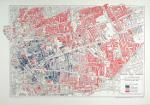 Russell & Lewis's 1900 map of Jewish East London [right] shows the density of Jewish settlement street by
street - from dark blue (over 95%) to dark pink (less than 5%). In this
parish, the dark blue areas were all north of the railway line: from
west to east, the Goodman's Fields area (then part of St Mark
Whitechapel), some streets to the east of Backchurch Lane (then part of
St John's parish), the area round Rampart Street, and the top of Watney
Street (then part of Christ Church parish). South of the railway, only
Cannon Street Road and Cable Street were predominantly Jewish, plus the
area north of the railway and west of Cannon Street Road. All other parts
of the parish are light or dark pink - including a few patches in the
Jewish 'heartlands': some of these were predominantly Irish.
Russell & Lewis's 1900 map of Jewish East London [right] shows the density of Jewish settlement street by
street - from dark blue (over 95%) to dark pink (less than 5%). In this
parish, the dark blue areas were all north of the railway line: from
west to east, the Goodman's Fields area (then part of St Mark
Whitechapel), some streets to the east of Backchurch Lane (then part of
St John's parish), the area round Rampart Street, and the top of Watney
Street (then part of Christ Church parish). South of the railway, only
Cannon Street Road and Cable Street were predominantly Jewish, plus the
area north of the railway and west of Cannon Street Road. All other parts
of the parish are light or dark pink - including a few patches in the
Jewish 'heartlands': some of these were predominantly Irish.
The details changed somewhat in the following years, but the pattern remained broadly the same.
Charles Booth's 1889/1898 poverty survey had noted The
German Jew is coming into St George's in large and increasing numbers.
They can live under conditions and so close together as to put to shame
the ordinary overcrowding of the English casual labourer ... There were
at one time only Irish colonies in St George's but these are slowly
giving way before the German Jew who ocupies their quarters and
supplants them in other ways. His secretaries saw their influence as mixed: although they contributed to appalling overcrowding, they presented a favourable contrast to the promiscuity of many of the English poor and could be seen as as cleaners or scavengers of districts of Irish poor, although this was not true in 'better' districts. See here for a sample local survey, and here for his listing of all the tailors working in the parish - predominantly Jewish, but some Irish - and here
for his more extended comments, published in 1902, combining concern
about the impact of Jewish settlement on the East End with a degree of
respect for their way of life and philanthropic arrangements.
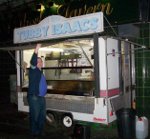
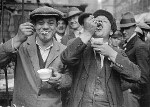
 Before
1939 there were some 80,000 Jews in the East End
and about 70 synagogues. However, although most homes were 'observant'
- keeping Sabbath and some or all of the dietary laws - synagogue
attendance was probably not more than 25% in most areas. The
institutions that promoted assimilation, education and career
aspiration were victims of their own success, with many of the
community prospering, moving on and 'marrying out'. Today it is
estimated that there are between two and three thousand Jews in the
'traditional' East End. There is not
a single kosher butcher (though plenty of halal ones), and the three
surviving synagogues struggle to
maintain a minyan (quorum of ten men) for the Shabbat service; others
have disappeared, often without a trace. But the Stepney Jewish Day
Centre (run by Jewish Care)
hosts about 700 people a week, and provides kosher meals on wheels.
There is a Jewish Society at Queen Mary College. And there are a few
remaining food shops, including Carmel Wines on the Mile End Road
(strictly kosher), some non-Beth Din bakers selling traditional bagels,
and Tubby Isaac's famous jellied eel stall remains near Aldgate East
station [right, then and now]: a commodity once common to all East Enders, which fell out of favour, but has recently become trendy.
Before
1939 there were some 80,000 Jews in the East End
and about 70 synagogues. However, although most homes were 'observant'
- keeping Sabbath and some or all of the dietary laws - synagogue
attendance was probably not more than 25% in most areas. The
institutions that promoted assimilation, education and career
aspiration were victims of their own success, with many of the
community prospering, moving on and 'marrying out'. Today it is
estimated that there are between two and three thousand Jews in the
'traditional' East End. There is not
a single kosher butcher (though plenty of halal ones), and the three
surviving synagogues struggle to
maintain a minyan (quorum of ten men) for the Shabbat service; others
have disappeared, often without a trace. But the Stepney Jewish Day
Centre (run by Jewish Care)
hosts about 700 people a week, and provides kosher meals on wheels.
There is a Jewish Society at Queen Mary College. And there are a few
remaining food shops, including Carmel Wines on the Mile End Road
(strictly kosher), some non-Beth Din bakers selling traditional bagels,
and Tubby Isaac's famous jellied eel stall remains near Aldgate East
station [right, then and now]: a commodity once common to all East Enders, which fell out of favour, but has recently become trendy.
Welfare agencies and housing initiatives
Various
welfare charities had been active in the first half of the 19th century to
cater for poor Jews in East London. Among those in this parish, see here for the Joel Emanuel Almshouse and the Hand in Hand Home which were based in Wellclose Square in the 1850s, and here
for the Jews' Orphan Asylum based in North Tenter Street from 1848-77,
and other Jewish influences in the Goodman's Field area. But with the
new influx in the latter years of the century, Baron Rothschild warned: We
have now a new Poland on our hands in East
London. Our first business is to humanise our Jewish immigrants and
then to Anglicise them.
(Basil Henriques later took the same approach.)
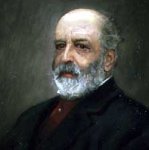 Lord Rothschild
(Nathaniel 'Natty' Mayer Rothschild) [right], head of the family bank after his
father's death in 1879, and the first (observant) Jewish peer (voting
with the Conservative and Unionists) was a key founder of the Four Per Cent Industrial Dwellings Company following the United Synagogue's 1884 enquiry into
'spiritual destitution'. Most of the patrons and tenants of their
'model artisan dwellings' were Jewish, particularly at the
Rothschild Buildings in Flower and Dean Street, which became a focal
point of Jewish life - see Jerry White Rothschild
Buildings: Life in an East End Tenement Block, 1887-1920 (Routledge
1980). (The company later built Albert Buildings
next to the Peabody Estate.) Notably, until his death in 1915, Lord Rothschild
was a trustee of the London Mosque Fund - a rôle later held by Lord Winterton.
Lord Rothschild
(Nathaniel 'Natty' Mayer Rothschild) [right], head of the family bank after his
father's death in 1879, and the first (observant) Jewish peer (voting
with the Conservative and Unionists) was a key founder of the Four Per Cent Industrial Dwellings Company following the United Synagogue's 1884 enquiry into
'spiritual destitution'. Most of the patrons and tenants of their
'model artisan dwellings' were Jewish, particularly at the
Rothschild Buildings in Flower and Dean Street, which became a focal
point of Jewish life - see Jerry White Rothschild
Buildings: Life in an East End Tenement Block, 1887-1920 (Routledge
1980). (The company later built Albert Buildings
next to the Peabody Estate.) Notably, until his death in 1915, Lord Rothschild
was a trustee of the London Mosque Fund - a rôle later held by Lord Winterton.
[Poor] Jews' Temporary Shelter


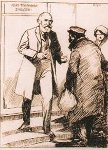
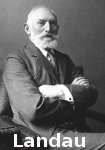 In 1885 a baker Simon Cohen, aka Becker, began to provide
temporary shelter at his premises in Church Lane, Whitechapel, but the
Board of Guardians closed it down: as the Jewish Chronicle reported, Its
abject misery is worse than any workhouse and it provides less food.
There is absolutely no sleeping accommodation except a wooden floor.
The only kind of daily food is rice and tea and bread and this is very
irregular. Let us get a ‘responsible committee’ or let a few gentlemen
see if they cannot get a few cheap mattresses for the older men to lie
upon at night and some blankets or rugs. Hermann Landau [right, and pictured welcoming immigrants at the Shelter], a
banker who had come from Poland in 1864 and had become an influential
member of the Jewish community, rose to the challenge, with a couple of
others (and, in the early years, some Rothschild funding), and in 1886
the Jews' Temporary Shelter was established at 84 Leman Street [left] as an institution
in which newcomers, having a little money, might obtain accommodation
and the necessaries they required at cost price, and where they would
receive useful advice. (It's said that its address was traded across eastern Europe to aspiring emigrants.) Those with some resources were referred
to local lodging houses, where they were soon propositioned by
furniture contractors and landlords; those without were
referred to the Soup Kitchen for the Jewish Poor and other charitable
bodies. In 1895 it received substantial
funding from another banker-philanthropist, Samuel Montagu [right], who became a Liberal MP and later a peer.
In 1885 a baker Simon Cohen, aka Becker, began to provide
temporary shelter at his premises in Church Lane, Whitechapel, but the
Board of Guardians closed it down: as the Jewish Chronicle reported, Its
abject misery is worse than any workhouse and it provides less food.
There is absolutely no sleeping accommodation except a wooden floor.
The only kind of daily food is rice and tea and bread and this is very
irregular. Let us get a ‘responsible committee’ or let a few gentlemen
see if they cannot get a few cheap mattresses for the older men to lie
upon at night and some blankets or rugs. Hermann Landau [right, and pictured welcoming immigrants at the Shelter], a
banker who had come from Poland in 1864 and had become an influential
member of the Jewish community, rose to the challenge, with a couple of
others (and, in the early years, some Rothschild funding), and in 1886
the Jews' Temporary Shelter was established at 84 Leman Street [left] as an institution
in which newcomers, having a little money, might obtain accommodation
and the necessaries they required at cost price, and where they would
receive useful advice. (It's said that its address was traded across eastern Europe to aspiring emigrants.) Those with some resources were referred
to local lodging houses, where they were soon propositioned by
furniture contractors and landlords; those without were
referred to the Soup Kitchen for the Jewish Poor and other charitable
bodies. In 1895 it received substantial
funding from another banker-philanthropist, Samuel Montagu [right], who became a Liberal MP and later a peer.
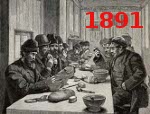
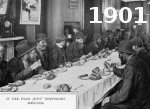
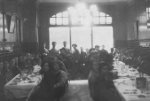 Early annual reports on the Shelter's work were defensive: most
immigrants were healthy and had good work skills, they said; the
accommodation was deliberately basic and temporary, and supported by
weekly subscriptions from other settlers; and by providing protection
against exploitation by the dockside 'crimpers' they enabled those who
wished to
move on, particularly to the USA or South Africa, to do so, with the
help of other welfare agencies which quickly developed the skills to enable this. By 1890 numbers had increased by 50%, but many
of these achieved 'transmigration' - or even a return home. Indeed, in
the coming decade the shelter negotiated agencies with shipping lines
(especially the Union Castle Line to South Africa) which provided
valuable funding.
The Shelter was effective and became trusted, and
more confident: for instance, in 1892 it ended the stealing of luggage
in Hamburg, in 1893 it co-operated with the Port of London Authority
medical officer in coping with a cholera epidemic; in 1896 it resolved
issues with exploited emigrants at the Dutch frontier, and in 1905
similar issues at German borders. At the turn of the century the
superintendent met every incoming ship carrying immigrants (receiving
notice by telegraph) to prevent abuses. Huge numbers passed
through its hands, some at short notice (253 Jews expelled by the Boers
in 1900, and a few months later 650 Romanians); between 1902-05 they
had assisted 16,000, some of whom were painstakingly processed
for onward journeys to the USA, for which a special ship was chartered.
But tension with the police remained - Landau explained that many
victims regarded the police as much the same as the dreaded objescik whom they had left behind -
and the shelter was raided because it was not registered under the
Common Lodging House Act, so had to stop its minimal charges. There
were more personal and local interventions, including payments for
proving a minyan (the quorum
of ten males to enable synagogue services), and issues about who should
receive immigrants on the Sabbath and at festivals.
Early annual reports on the Shelter's work were defensive: most
immigrants were healthy and had good work skills, they said; the
accommodation was deliberately basic and temporary, and supported by
weekly subscriptions from other settlers; and by providing protection
against exploitation by the dockside 'crimpers' they enabled those who
wished to
move on, particularly to the USA or South Africa, to do so, with the
help of other welfare agencies which quickly developed the skills to enable this. By 1890 numbers had increased by 50%, but many
of these achieved 'transmigration' - or even a return home. Indeed, in
the coming decade the shelter negotiated agencies with shipping lines
(especially the Union Castle Line to South Africa) which provided
valuable funding.
The Shelter was effective and became trusted, and
more confident: for instance, in 1892 it ended the stealing of luggage
in Hamburg, in 1893 it co-operated with the Port of London Authority
medical officer in coping with a cholera epidemic; in 1896 it resolved
issues with exploited emigrants at the Dutch frontier, and in 1905
similar issues at German borders. At the turn of the century the
superintendent met every incoming ship carrying immigrants (receiving
notice by telegraph) to prevent abuses. Huge numbers passed
through its hands, some at short notice (253 Jews expelled by the Boers
in 1900, and a few months later 650 Romanians); between 1902-05 they
had assisted 16,000, some of whom were painstakingly processed
for onward journeys to the USA, for which a special ship was chartered.
But tension with the police remained - Landau explained that many
victims regarded the police as much the same as the dreaded objescik whom they had left behind -
and the shelter was raided because it was not registered under the
Common Lodging House Act, so had to stop its minimal charges. There
were more personal and local interventions, including payments for
proving a minyan (the quorum
of ten males to enable synagogue services), and issues about who should
receive immigrants on the Sabbath and at festivals.
What radically changed the nature of the Shelter's work was the 1905
Aliens Act, mentioned above, which restricted immigration on public health and housing grounds: see Bernard Gainer The Alien Invasion: the origins of the Aliens Act of 1905 (Heinemann 1972). Herbert Asquith, the Liberal Home
Secretary, had recently visited the Shelter and spoke of the plight of
the Russian refugees he had met, but the Act was passed, and
henceforward the Shelter became involved in advocacy, translation,
appeal work and guaranteeing bonds for would-be migrants. There was
also work with non-Jewish migrants, including in 1910 an appeal from
the Thompson Line to help travellers to the USA and Australia, and
assistance given to Canada-bound emigrants whose ship had caught fire.
But up to and through the First World War the priority to help eastern
European Jews remained (during the war, some came via Belgium).
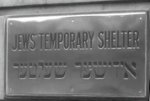
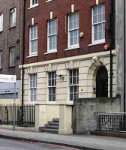 In 1906 the Shelter had moved to 63 Mansell Street [right, today - rebuilt in 1930 in neo-Georgian style by Lewis Solomon]; in 1914 the word 'poor' was removed from the title. There were various
crises in the inter-war period, such as the 1923 change in US
immigration law which stranded many; but, of course, the greater crisis
came from Europe itself. By 1937 1,183,000 people had been met at the
docks (and they were now being met at railway stations too); 126,000 had
stayed at the shelter, including a fair number of non-Jews, as noted in a 1937 appeal (endorsed
by the Austrian writer Stefan Zweig with a pamplet House of a Thousand
Destinies). During the Second World War bombed-out
locals were accommodated, until the buildng was requisitioned for
American troops in 1943, and was used after the war to receive children
from displaced persons camps and refugees from Europe and the middle
East.
In 1906 the Shelter had moved to 63 Mansell Street [right, today - rebuilt in 1930 in neo-Georgian style by Lewis Solomon]; in 1914 the word 'poor' was removed from the title. There were various
crises in the inter-war period, such as the 1923 change in US
immigration law which stranded many; but, of course, the greater crisis
came from Europe itself. By 1937 1,183,000 people had been met at the
docks (and they were now being met at railway stations too); 126,000 had
stayed at the shelter, including a fair number of non-Jews, as noted in a 1937 appeal (endorsed
by the Austrian writer Stefan Zweig with a pamplet House of a Thousand
Destinies). During the Second World War bombed-out
locals were accommodated, until the buildng was requisitioned for
American troops in 1943, and was used after the war to receive children
from displaced persons camps and refugees from Europe and the middle
East.
The work was now increasingly advisory, and in 1973 the Shelter moved
to smaller (25-bed) well-appointed premises in Mapesbury Road, Kilburn,
but because of changes in the law this was under-used; it closed in
the 1990s (it is leased for student accommodation), and a part-time
administrator now uses the funds for emergency grants. (The Mansell
Street building is now a private clinic, but retains the name-plate - right.)
Jews' Free School; self-help organisations
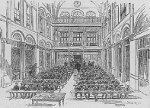
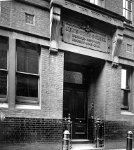 The school had
been founded by Joshua van Oven in 1817, in Bell Lane, Spitalfields [Great Hall left] -
through traces its origins back to a Talmud Torah set up for a couple
of dozen orphan boys in 1732 by affluent members of the Ashkenazi Great
Synagogue. By the turn of the 20th century, supported by the
Rothschilds, it laid claim to
be the
largest secondary school in the world, with over 4,000 pupils (boys and
girls) [doorway left]. [The 'JFS' is now in Kenton, and in recent years has been involved in
controversy over its admissions policy.]
The school had
been founded by Joshua van Oven in 1817, in Bell Lane, Spitalfields [Great Hall left] -
through traces its origins back to a Talmud Torah set up for a couple
of dozen orphan boys in 1732 by affluent members of the Ashkenazi Great
Synagogue. By the turn of the 20th century, supported by the
Rothschilds, it laid claim to
be the
largest secondary school in the world, with over 4,000 pupils (boys and
girls) [doorway left]. [The 'JFS' is now in Kenton, and in recent years has been involved in
controversy over its admissions policy.]
Self-help organisations burgeoned. The ethos of the friendly society
- often coupled with ritual and regalia, and status for its officers -
had a particular appeal. The order Achei Brith, founded in 1888, had
2,800 members over thirty lodges, and a capital fund of £7,000. There
was also the Grand Order of Israel, the Hebrew Order of Druids [sic!]
and the Ancient Order of Maccabæans (an early advocate of the Zionist
cause), and smaller associations named after Russian and Polish towns,
of which the Cracow Jewish Friendly Society (established 1864, first meeting at the Angel and Crown in Whitechapel, and in due course claiming about 380 members,
with a base at the Cannon Street Road Synagogue), was the largest.
'The Hutch'
 In 1872 a Jewish Working Men's Club & Lads' Institute
had been founded by the Jewish Association for the Diffusion of
Religious Knowledge, with a reading room and lecture hall at Hutchison
House, Hutchison Street, Aldgate; Samuel Montagu
was President. Becoming independent two years later, they added a
library, games, entertainments and other club features for 400 members
of both sexes. In 1883, a purpose-built club for 1,500 was built in
Great Alie Street, with a Lads' Institute for boys between 14 and 20.
Membership continued to increase; the Lads' Institute returned to
Hutchison Street, and in 1892 the Great Alie Street premises were
enlarged at a cost of £4,000. By 1905 there were 975 members, and the Hutchison House Club
was created by the Rothschild family in conjunction with Max Bonn
(1877-1938, an American-born merchant banker, later Sir Max Bonn KBE)
and Frank Goldsmith MP, based at Camperdown House, in Half Moon
Passage. (In 1915 they offered these premises to the government for war
work; in 1918 the newly-raised Jewish Battalion
of the 38th Royal Fusiliers had a kosher meal here and was inspected
in Great Alie Street by Lt. Gen. Sir Francis Lloyd, as part of its
famous march through Whitechapel; in the 1920s, social work conferences
were held here.)
In 1872 a Jewish Working Men's Club & Lads' Institute
had been founded by the Jewish Association for the Diffusion of
Religious Knowledge, with a reading room and lecture hall at Hutchison
House, Hutchison Street, Aldgate; Samuel Montagu
was President. Becoming independent two years later, they added a
library, games, entertainments and other club features for 400 members
of both sexes. In 1883, a purpose-built club for 1,500 was built in
Great Alie Street, with a Lads' Institute for boys between 14 and 20.
Membership continued to increase; the Lads' Institute returned to
Hutchison Street, and in 1892 the Great Alie Street premises were
enlarged at a cost of £4,000. By 1905 there were 975 members, and the Hutchison House Club
was created by the Rothschild family in conjunction with Max Bonn
(1877-1938, an American-born merchant banker, later Sir Max Bonn KBE)
and Frank Goldsmith MP, based at Camperdown House, in Half Moon
Passage. (In 1915 they offered these premises to the government for war
work; in 1918 the newly-raised Jewish Battalion
of the 38th Royal Fusiliers had a kosher meal here and was inspected
in Great Alie Street by Lt. Gen. Sir Francis Lloyd, as part of its
famous march through Whitechapel; in the 1920s, social work conferences
were held here.)
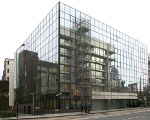 It
thus became one of several local agencies committed to encouraging
young people to combine loyalty to faith and citizenship - see below
for another example - particularly through sport ('the sunshine of
manly sports and pastimes'). It was also the HQ of the Jewish Lads' and
Girls' Brigade (in some rivalry with Jewish scout troops). When the
club closed, administrative activities transferred to north London; in
more recent times, it has funded a London University research
fellowship: see Sharman Kadish A Good Jew and a Good Englishman (Vallentine Mitchell 1995). Pictured is present-day Camperdown House, an office block at 6 Braham Street.
It
thus became one of several local agencies committed to encouraging
young people to combine loyalty to faith and citizenship - see below
for another example - particularly through sport ('the sunshine of
manly sports and pastimes'). It was also the HQ of the Jewish Lads' and
Girls' Brigade (in some rivalry with Jewish scout troops). When the
club closed, administrative activities transferred to north London; in
more recent times, it has funded a London University research
fellowship: see Sharman Kadish A Good Jew and a Good Englishman (Vallentine Mitchell 1995). Pictured is present-day Camperdown House, an office block at 6 Braham Street.
(See here for the Jewish Working Girls' Club, established in Leman Street in 1886.)
Political and Friendly Societies: Workers' Circle (Arbeiter Ring), Workers' Friend (Arbeiter Fraint)
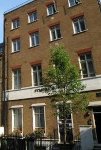 The
centre of working-class left wing activism was the Workers'
Circle,
which functioned as a friendly society and a cultural, social and
political club, established by cabinet-makers in an upstairs room in
Brick Lane in 1909. Its membership was
broad, including trade unionists, Marxists and Communists, Labour Party
members, anarchists and Zionists. Between the wars 20 branches were
established, in London and elsewhere, with total membership rising to
about 3,000 by 1939, after which it declined (it disbanded in 1985).
It owned a rest home in Littlehampton. Symons House at 22 Alie
Street [right today] became its
headquarters in 1924, providing lectures,
concerts, dances, debates and classes. Workers gathered in its canteen
to read newspapers, drink tea and argue, finding, as one writer put it, consolation, a spiritual refuge from their
struggle with the day-to-day world, a place to recharge their dreams. [The only Jewish Friendly Society now remaining is The Grand Order of David and Shield of Israel Friendly Society, which now functions solely as a social club.]
The
centre of working-class left wing activism was the Workers'
Circle,
which functioned as a friendly society and a cultural, social and
political club, established by cabinet-makers in an upstairs room in
Brick Lane in 1909. Its membership was
broad, including trade unionists, Marxists and Communists, Labour Party
members, anarchists and Zionists. Between the wars 20 branches were
established, in London and elsewhere, with total membership rising to
about 3,000 by 1939, after which it declined (it disbanded in 1985).
It owned a rest home in Littlehampton. Symons House at 22 Alie
Street [right today] became its
headquarters in 1924, providing lectures,
concerts, dances, debates and classes. Workers gathered in its canteen
to read newspapers, drink tea and argue, finding, as one writer put it, consolation, a spiritual refuge from their
struggle with the day-to-day world, a place to recharge their dreams. [The only Jewish Friendly Society now remaining is The Grand Order of David and Shield of Israel Friendly Society, which now functions solely as a social club.]
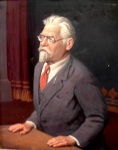 40 Berner [Henriques] Street housed the International Working Men's Club, and was also for a time the print works of the anarchist Yiddish newspaper Arbeiter Fraint (Workers’ Friend), which was edited for a time by Rudolf Rocker [left, a
painting by his son Fermin] who came to London from Germany in the
1890s. But in 1900 one of many financial crises forced a move to a smelly shed
in Stepney Green. See further Bill Fishman East End Jewish Radicals 1875 -1914. Jewish anarchists and socialists have been active in the area ever since.
40 Berner [Henriques] Street housed the International Working Men's Club, and was also for a time the print works of the anarchist Yiddish newspaper Arbeiter Fraint (Workers’ Friend), which was edited for a time by Rudolf Rocker [left, a
painting by his son Fermin] who came to London from Germany in the
1890s. But in 1900 one of many financial crises forced a move to a smelly shed
in Stepney Green. See further Bill Fishman East End Jewish Radicals 1875 -1914. Jewish anarchists and socialists have been active in the area ever since.
Theatres


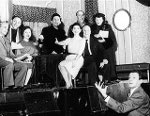
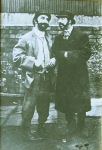 A regular topic of conversation in the street was the productions at
the two Yiddish theatres in the area, the Pavilion Theatre in
Whitechapel Road (closed in 1936) and the Grand Palais at 131-139 Commercial Road (opposite Umberston Street). The Grand
Palais [doorway left] opened in 1926 in a former cinema, and survived in regular use
until 1961 [left are Leo Fuchs and the company rehearsing in 1956, and Max Bacon, a regular
performer - on the right of the photo], with occasional performances
until 1970 when it became a bingo hall.
A regular topic of conversation in the street was the productions at
the two Yiddish theatres in the area, the Pavilion Theatre in
Whitechapel Road (closed in 1936) and the Grand Palais at 131-139 Commercial Road (opposite Umberston Street). The Grand
Palais [doorway left] opened in 1926 in a former cinema, and survived in regular use
until 1961 [left are Leo Fuchs and the company rehearsing in 1956, and Max Bacon, a regular
performer - on the right of the photo], with occasional performances
until 1970 when it became a bingo hall.


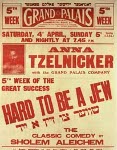 Its most
famous production was the 1943 wartime hit musical Der Kenig fun Lampeduza (The
King of Lampedusa), starring Romanian-born Meier Tzelniker (1898-1980)
and his daughter Anna,
b.1922 [left, plus a poster for another production]. (See here for the 2013 Lampedusa boat tragedy.) They also acted together in Yiddish productions of
Shakespeare (e.g. Meier as Shylock and Anna as Portia in The Merchant of Venice, in 1946 - a thrilling experience, said the Jewish Chronicle),
put on by the Jewish National Theatre which Meier formed in 1936 with
Fanny Waxman (Anna's husband Phil Bernstein became its musical
director). Anna also featured in Lionel Bart's Blitz!, singing 'Petticoat Lane (on a Saturday ain't so nice)', and in more recent years regularly
recited her father's Yiddish poem about Hessel Street Market. The Grand Palais site now houses Flick Fashions [right],
whose main offices are round the corner in Cavell Street: part of the
doorway remains. Footage of the theatre can be seen in the 1967 James
Mason film The London Nobody Knows.
Its most
famous production was the 1943 wartime hit musical Der Kenig fun Lampeduza (The
King of Lampedusa), starring Romanian-born Meier Tzelniker (1898-1980)
and his daughter Anna,
b.1922 [left, plus a poster for another production]. (See here for the 2013 Lampedusa boat tragedy.) They also acted together in Yiddish productions of
Shakespeare (e.g. Meier as Shylock and Anna as Portia in The Merchant of Venice, in 1946 - a thrilling experience, said the Jewish Chronicle),
put on by the Jewish National Theatre which Meier formed in 1936 with
Fanny Waxman (Anna's husband Phil Bernstein became its musical
director). Anna also featured in Lionel Bart's Blitz!, singing 'Petticoat Lane (on a Saturday ain't so nice)', and in more recent years regularly
recited her father's Yiddish poem about Hessel Street Market. The Grand Palais site now houses Flick Fashions [right],
whose main offices are round the corner in Cavell Street: part of the
doorway remains. Footage of the theatre can be seen in the 1967 James
Mason film The London Nobody Knows.
Thus
over time what has been described as a 'miniature welfare state' for
the Jewish East End, with various political complexions, emerged. See this (racist) article of 1894 about anarchist groups. This 1896 article comments on the
range of Jewish activities in Whitechapel, and this 1911 article
favourably but somewhat sentimentally contrasts the 'Jewish' end of Cable Street,
around the Shelter, with its 'Irish' end.
Vibrant
patterns of Jewish life had emerged, with Yiddish newspapers, theatres, the Hessel Street market
and many social, philanthropic and political
organisations. The First World War brought sharp tensions, as many
German and Austrian-born Jews were interned under the Aliens
Restriction Act of 1914. Samuel Montagu, Lord Rothschild and other members of the Board of Deputies of British Jews were the signatories of this letter appealing for help on behalf of the Russo-Jewish Committee in London to assist the
victims of the pogroms in Russia.
See further pages on local Jewish life:
Jewish Presence (2) - Synagogues in the parish
Jewish Presence (3) - St George's Settlement Synagogue
Jewish Presence (4) - Hessel Street
Jewish Presence (5) - convert clergy
Back to History page


 note:
the Whitechapel Gallery, a fine Arts & Crafts building of 1901 designed by Charles Harrison Townsend, restored and extended in 2009, became a
focal point for Jewish intellectual life in the area ('the University of the Ghetto'), and its reading
room and exhibitions reflect this, as does Bernard Kops' poem Whitechapel Library, Aldgate East. Our local First World War poet Isaac Rosenberg is commemorated here with a blue plaque.The London Metropolitan Archives has
a good display of Jewish life in the East End, based around a wall-size
version of the map shown below.
note:
the Whitechapel Gallery, a fine Arts & Crafts building of 1901 designed by Charles Harrison Townsend, restored and extended in 2009, became a
focal point for Jewish intellectual life in the area ('the University of the Ghetto'), and its reading
room and exhibitions reflect this, as does Bernard Kops' poem Whitechapel Library, Aldgate East. Our local First World War poet Isaac Rosenberg is commemorated here with a blue plaque.The London Metropolitan Archives has
a good display of Jewish life in the East End, based around a wall-size
version of the map shown below.
 G. Eugene
Harfield's handsomely-printed Commercial
Directory of the Jews of the United Kingdom (Hewlett
& Pierce 5634/1894), listing established traders and professionals
(including barristers) throughout the land, is a sign of the desire to
make good by assimilation, which a flood of poor immigrants threatened
- see below. Significantly, its title page [right] combines Palestinian
aspirations and loyalty to the Crown. (See here
for the listings of shops and businesses in this parish.) By
contrast, many
eastern European immigrants espoused radical politics: see here for
a scurrilous, and racist, article from the Evening Standard of
1894 on the 'haunts of the anarchists'.
G. Eugene
Harfield's handsomely-printed Commercial
Directory of the Jews of the United Kingdom (Hewlett
& Pierce 5634/1894), listing established traders and professionals
(including barristers) throughout the land, is a sign of the desire to
make good by assimilation, which a flood of poor immigrants threatened
- see below. Significantly, its title page [right] combines Palestinian
aspirations and loyalty to the Crown. (See here
for the listings of shops and businesses in this parish.) By
contrast, many
eastern European immigrants espoused radical politics: see here for
a scurrilous, and racist, article from the Evening Standard of
1894 on the 'haunts of the anarchists'. Russell & Lewis's 1900 map of Jewish East London [right] shows the density of Jewish settlement street by
street - from dark blue (over 95%) to dark pink (less than 5%). In this
parish, the dark blue areas were all north of the railway line: from
west to east, the Goodman's Fields area (then part of St Mark
Whitechapel), some streets to the east of Backchurch Lane (then part of
St John's parish), the area round Rampart Street, and the top of Watney
Street (then part of Christ Church parish). South of the railway, only
Cannon Street Road and Cable Street were predominantly Jewish, plus the
area north of the railway and west of Cannon Street Road. All other parts
of the parish are light or dark pink - including a few patches in the
Jewish 'heartlands': some of these were predominantly Irish.
Russell & Lewis's 1900 map of Jewish East London [right] shows the density of Jewish settlement street by
street - from dark blue (over 95%) to dark pink (less than 5%). In this
parish, the dark blue areas were all north of the railway line: from
west to east, the Goodman's Fields area (then part of St Mark
Whitechapel), some streets to the east of Backchurch Lane (then part of
St John's parish), the area round Rampart Street, and the top of Watney
Street (then part of Christ Church parish). South of the railway, only
Cannon Street Road and Cable Street were predominantly Jewish, plus the
area north of the railway and west of Cannon Street Road. All other parts
of the parish are light or dark pink - including a few patches in the
Jewish 'heartlands': some of these were predominantly Irish.

 Before
1939 there were some 80,000 Jews in the East End
and about 70 synagogues. However, although most homes were 'observant'
- keeping Sabbath and some or all of the dietary laws - synagogue
attendance was probably not more than 25% in most areas. The
institutions that promoted assimilation, education and career
aspiration were victims of their own success, with many of the
community prospering, moving on and 'marrying out'. Today it is
estimated that there are between two and three thousand Jews in the
'traditional' East End. There is not
a single kosher butcher (though plenty of halal ones), and the three
surviving synagogues struggle to
maintain a minyan (quorum of ten men) for the Shabbat service; others
have disappeared, often without a trace. But the Stepney Jewish Day
Centre (run by Jewish Care)
hosts about 700 people a week, and provides kosher meals on wheels.
There is a Jewish Society at Queen Mary College. And there are a few
remaining food shops, including Carmel Wines on the Mile End Road
(strictly kosher), some non-Beth Din bakers selling traditional bagels,
and Tubby Isaac's famous jellied eel stall remains near Aldgate East
station [right, then and now]: a commodity once common to all East Enders, which fell out of favour, but has recently become trendy.
Before
1939 there were some 80,000 Jews in the East End
and about 70 synagogues. However, although most homes were 'observant'
- keeping Sabbath and some or all of the dietary laws - synagogue
attendance was probably not more than 25% in most areas. The
institutions that promoted assimilation, education and career
aspiration were victims of their own success, with many of the
community prospering, moving on and 'marrying out'. Today it is
estimated that there are between two and three thousand Jews in the
'traditional' East End. There is not
a single kosher butcher (though plenty of halal ones), and the three
surviving synagogues struggle to
maintain a minyan (quorum of ten men) for the Shabbat service; others
have disappeared, often without a trace. But the Stepney Jewish Day
Centre (run by Jewish Care)
hosts about 700 people a week, and provides kosher meals on wheels.
There is a Jewish Society at Queen Mary College. And there are a few
remaining food shops, including Carmel Wines on the Mile End Road
(strictly kosher), some non-Beth Din bakers selling traditional bagels,
and Tubby Isaac's famous jellied eel stall remains near Aldgate East
station [right, then and now]: a commodity once common to all East Enders, which fell out of favour, but has recently become trendy. Lord Rothschild
(Nathaniel 'Natty' Mayer Rothschild) [right], head of the family bank after his
father's death in 1879, and the first (observant) Jewish peer (voting
with the Conservative and Unionists) was a key founder of the Four Per Cent Industrial Dwellings Company following the United Synagogue's 1884 enquiry into
'spiritual destitution'. Most of the patrons and tenants of their
'model artisan dwellings' were Jewish, particularly at the
Rothschild Buildings in Flower and Dean Street, which became a focal
point of Jewish life - see Jerry White Rothschild
Buildings: Life in an East End Tenement Block, 1887-1920 (Routledge
1980). (The company later built Albert Buildings
next to the Peabody Estate.) Notably, until his death in 1915, Lord Rothschild
was a trustee of the London Mosque Fund - a rôle later held by Lord Winterton.
Lord Rothschild
(Nathaniel 'Natty' Mayer Rothschild) [right], head of the family bank after his
father's death in 1879, and the first (observant) Jewish peer (voting
with the Conservative and Unionists) was a key founder of the Four Per Cent Industrial Dwellings Company following the United Synagogue's 1884 enquiry into
'spiritual destitution'. Most of the patrons and tenants of their
'model artisan dwellings' were Jewish, particularly at the
Rothschild Buildings in Flower and Dean Street, which became a focal
point of Jewish life - see Jerry White Rothschild
Buildings: Life in an East End Tenement Block, 1887-1920 (Routledge
1980). (The company later built Albert Buildings
next to the Peabody Estate.) Notably, until his death in 1915, Lord Rothschild
was a trustee of the London Mosque Fund - a rôle later held by Lord Winterton. 


 In 1885 a baker Simon Cohen, aka Becker, began to provide
temporary shelter at his premises in Church Lane, Whitechapel, but the
Board of Guardians closed it down: as the Jewish Chronicle reported, Its
abject misery is worse than any workhouse and it provides less food.
There is absolutely no sleeping accommodation except a wooden floor.
The only kind of daily food is rice and tea and bread and this is very
irregular. Let us get a ‘responsible committee’ or let a few gentlemen
see if they cannot get a few cheap mattresses for the older men to lie
upon at night and some blankets or rugs. Hermann Landau [right, and pictured welcoming immigrants at the Shelter], a
banker who had come from Poland in 1864 and had become an influential
member of the Jewish community, rose to the challenge, with a couple of
others (and, in the early years, some Rothschild funding), and in 1886
the Jews' Temporary Shelter was established at 84 Leman Street [left] as an institution
in which newcomers, having a little money, might obtain accommodation
and the necessaries they required at cost price, and where they would
receive useful advice. (It's said that its address was traded across eastern Europe to aspiring emigrants.) Those with some resources were referred
to local lodging houses, where they were soon propositioned by
furniture contractors and landlords; those without were
referred to the Soup Kitchen for the Jewish Poor and other charitable
bodies. In 1895 it received substantial
funding from another banker-philanthropist, Samuel Montagu [right], who became a Liberal MP and later a peer.
In 1885 a baker Simon Cohen, aka Becker, began to provide
temporary shelter at his premises in Church Lane, Whitechapel, but the
Board of Guardians closed it down: as the Jewish Chronicle reported, Its
abject misery is worse than any workhouse and it provides less food.
There is absolutely no sleeping accommodation except a wooden floor.
The only kind of daily food is rice and tea and bread and this is very
irregular. Let us get a ‘responsible committee’ or let a few gentlemen
see if they cannot get a few cheap mattresses for the older men to lie
upon at night and some blankets or rugs. Hermann Landau [right, and pictured welcoming immigrants at the Shelter], a
banker who had come from Poland in 1864 and had become an influential
member of the Jewish community, rose to the challenge, with a couple of
others (and, in the early years, some Rothschild funding), and in 1886
the Jews' Temporary Shelter was established at 84 Leman Street [left] as an institution
in which newcomers, having a little money, might obtain accommodation
and the necessaries they required at cost price, and where they would
receive useful advice. (It's said that its address was traded across eastern Europe to aspiring emigrants.) Those with some resources were referred
to local lodging houses, where they were soon propositioned by
furniture contractors and landlords; those without were
referred to the Soup Kitchen for the Jewish Poor and other charitable
bodies. In 1895 it received substantial
funding from another banker-philanthropist, Samuel Montagu [right], who became a Liberal MP and later a peer. 

 Early annual reports on the Shelter's work were defensive: most
immigrants were healthy and had good work skills, they said; the
accommodation was deliberately basic and temporary, and supported by
weekly subscriptions from other settlers; and by providing protection
against exploitation by the dockside 'crimpers' they enabled those who
wished to
move on, particularly to the USA or South Africa, to do so, with the
help of other welfare agencies which quickly developed the skills to enable this. By 1890 numbers had increased by 50%, but many
of these achieved 'transmigration' - or even a return home. Indeed, in
the coming decade the shelter negotiated agencies with shipping lines
(especially the Union Castle Line to South Africa) which provided
valuable funding.
The Shelter was effective and became trusted, and
more confident: for instance, in 1892 it ended the stealing of luggage
in Hamburg, in 1893 it co-operated with the Port of London Authority
medical officer in coping with a cholera epidemic; in 1896 it resolved
issues with exploited emigrants at the Dutch frontier, and in 1905
similar issues at German borders. At the turn of the century the
superintendent met every incoming ship carrying immigrants (receiving
notice by telegraph) to prevent abuses. Huge numbers passed
through its hands, some at short notice (253 Jews expelled by the Boers
in 1900, and a few months later 650 Romanians); between 1902-05 they
had assisted 16,000, some of whom were painstakingly processed
for onward journeys to the USA, for which a special ship was chartered.
But tension with the police remained - Landau explained that many
victims regarded the police as much the same as the dreaded objescik whom they had left behind -
and the shelter was raided because it was not registered under the
Common Lodging House Act, so had to stop its minimal charges. There
were more personal and local interventions, including payments for
proving a minyan (the quorum
of ten males to enable synagogue services), and issues about who should
receive immigrants on the Sabbath and at festivals.
Early annual reports on the Shelter's work were defensive: most
immigrants were healthy and had good work skills, they said; the
accommodation was deliberately basic and temporary, and supported by
weekly subscriptions from other settlers; and by providing protection
against exploitation by the dockside 'crimpers' they enabled those who
wished to
move on, particularly to the USA or South Africa, to do so, with the
help of other welfare agencies which quickly developed the skills to enable this. By 1890 numbers had increased by 50%, but many
of these achieved 'transmigration' - or even a return home. Indeed, in
the coming decade the shelter negotiated agencies with shipping lines
(especially the Union Castle Line to South Africa) which provided
valuable funding.
The Shelter was effective and became trusted, and
more confident: for instance, in 1892 it ended the stealing of luggage
in Hamburg, in 1893 it co-operated with the Port of London Authority
medical officer in coping with a cholera epidemic; in 1896 it resolved
issues with exploited emigrants at the Dutch frontier, and in 1905
similar issues at German borders. At the turn of the century the
superintendent met every incoming ship carrying immigrants (receiving
notice by telegraph) to prevent abuses. Huge numbers passed
through its hands, some at short notice (253 Jews expelled by the Boers
in 1900, and a few months later 650 Romanians); between 1902-05 they
had assisted 16,000, some of whom were painstakingly processed
for onward journeys to the USA, for which a special ship was chartered.
But tension with the police remained - Landau explained that many
victims regarded the police as much the same as the dreaded objescik whom they had left behind -
and the shelter was raided because it was not registered under the
Common Lodging House Act, so had to stop its minimal charges. There
were more personal and local interventions, including payments for
proving a minyan (the quorum
of ten males to enable synagogue services), and issues about who should
receive immigrants on the Sabbath and at festivals.
 In 1906 the Shelter had moved to 63 Mansell Street [right, today - rebuilt in 1930 in neo-Georgian style by Lewis Solomon]; in 1914 the word 'poor' was removed from the title. There were various
crises in the inter-war period, such as the 1923 change in US
immigration law which stranded many; but, of course, the greater crisis
came from Europe itself. By 1937 1,183,000 people had been met at the
docks (and they were now being met at railway stations too); 126,000 had
stayed at the shelter, including a fair number of non-Jews, as noted in a 1937 appeal (endorsed
by the Austrian writer Stefan Zweig with a pamplet House of a Thousand
Destinies). During the Second World War bombed-out
locals were accommodated, until the buildng was requisitioned for
American troops in 1943, and was used after the war to receive children
from displaced persons camps and refugees from Europe and the middle
East.
In 1906 the Shelter had moved to 63 Mansell Street [right, today - rebuilt in 1930 in neo-Georgian style by Lewis Solomon]; in 1914 the word 'poor' was removed from the title. There were various
crises in the inter-war period, such as the 1923 change in US
immigration law which stranded many; but, of course, the greater crisis
came from Europe itself. By 1937 1,183,000 people had been met at the
docks (and they were now being met at railway stations too); 126,000 had
stayed at the shelter, including a fair number of non-Jews, as noted in a 1937 appeal (endorsed
by the Austrian writer Stefan Zweig with a pamplet House of a Thousand
Destinies). During the Second World War bombed-out
locals were accommodated, until the buildng was requisitioned for
American troops in 1943, and was used after the war to receive children
from displaced persons camps and refugees from Europe and the middle
East.
 The school had
been founded by Joshua van Oven in 1817, in Bell Lane, Spitalfields [Great Hall left] -
through traces its origins back to a Talmud Torah set up for a couple
of dozen orphan boys in 1732 by affluent members of the Ashkenazi Great
Synagogue. By the turn of the 20th century, supported by the
Rothschilds, it laid claim to
be the
largest secondary school in the world, with over 4,000 pupils (boys and
girls) [doorway left]. [The 'JFS' is now in Kenton, and in recent years has been involved in
controversy over its admissions policy.]
The school had
been founded by Joshua van Oven in 1817, in Bell Lane, Spitalfields [Great Hall left] -
through traces its origins back to a Talmud Torah set up for a couple
of dozen orphan boys in 1732 by affluent members of the Ashkenazi Great
Synagogue. By the turn of the 20th century, supported by the
Rothschilds, it laid claim to
be the
largest secondary school in the world, with over 4,000 pupils (boys and
girls) [doorway left]. [The 'JFS' is now in Kenton, and in recent years has been involved in
controversy over its admissions policy.]  In 1872 a Jewish Working Men's Club & Lads' Institute
had been founded by the Jewish Association for the Diffusion of
Religious Knowledge, with a reading room and lecture hall at Hutchison
House, Hutchison Street, Aldgate; Samuel Montagu
was President. Becoming independent two years later, they added a
library, games, entertainments and other club features for 400 members
of both sexes. In 1883, a purpose-built club for 1,500 was built in
Great Alie Street, with a Lads' Institute for boys between 14 and 20.
Membership continued to increase; the Lads' Institute returned to
Hutchison Street, and in 1892 the Great Alie Street premises were
enlarged at a cost of £4,000. By 1905 there were 975 members, and the Hutchison House Club
was created by the Rothschild family in conjunction with Max Bonn
(1877-1938, an American-born merchant banker, later Sir Max Bonn KBE)
and Frank Goldsmith MP, based at Camperdown House, in Half Moon
Passage. (In 1915 they offered these premises to the government for war
work; in 1918 the newly-raised Jewish Battalion
of the 38th Royal Fusiliers had a kosher meal here and was inspected
in Great Alie Street by Lt. Gen. Sir Francis Lloyd, as part of its
famous march through Whitechapel; in the 1920s, social work conferences
were held here.)
In 1872 a Jewish Working Men's Club & Lads' Institute
had been founded by the Jewish Association for the Diffusion of
Religious Knowledge, with a reading room and lecture hall at Hutchison
House, Hutchison Street, Aldgate; Samuel Montagu
was President. Becoming independent two years later, they added a
library, games, entertainments and other club features for 400 members
of both sexes. In 1883, a purpose-built club for 1,500 was built in
Great Alie Street, with a Lads' Institute for boys between 14 and 20.
Membership continued to increase; the Lads' Institute returned to
Hutchison Street, and in 1892 the Great Alie Street premises were
enlarged at a cost of £4,000. By 1905 there were 975 members, and the Hutchison House Club
was created by the Rothschild family in conjunction with Max Bonn
(1877-1938, an American-born merchant banker, later Sir Max Bonn KBE)
and Frank Goldsmith MP, based at Camperdown House, in Half Moon
Passage. (In 1915 they offered these premises to the government for war
work; in 1918 the newly-raised Jewish Battalion
of the 38th Royal Fusiliers had a kosher meal here and was inspected
in Great Alie Street by Lt. Gen. Sir Francis Lloyd, as part of its
famous march through Whitechapel; in the 1920s, social work conferences
were held here.)  It
thus became one of several local agencies committed to encouraging
young people to combine loyalty to faith and citizenship - see below
for another example - particularly through sport ('the sunshine of
manly sports and pastimes'). It was also the HQ of the Jewish Lads' and
Girls' Brigade (in some rivalry with Jewish scout troops). When the
club closed, administrative activities transferred to north London; in
more recent times, it has funded a London University research
fellowship: see Sharman Kadish A Good Jew and a Good Englishman (Vallentine Mitchell 1995). Pictured is present-day Camperdown House, an office block at 6 Braham Street.
It
thus became one of several local agencies committed to encouraging
young people to combine loyalty to faith and citizenship - see below
for another example - particularly through sport ('the sunshine of
manly sports and pastimes'). It was also the HQ of the Jewish Lads' and
Girls' Brigade (in some rivalry with Jewish scout troops). When the
club closed, administrative activities transferred to north London; in
more recent times, it has funded a London University research
fellowship: see Sharman Kadish A Good Jew and a Good Englishman (Vallentine Mitchell 1995). Pictured is present-day Camperdown House, an office block at 6 Braham Street. The
centre of working-class left wing activism was the Workers'
Circle,
which functioned as a friendly society and a cultural, social and
political club, established by cabinet-makers in an upstairs room in
Brick Lane in 1909. Its membership was
broad, including trade unionists, Marxists and Communists, Labour Party
members, anarchists and Zionists. Between the wars 20 branches were
established, in London and elsewhere, with total membership rising to
about 3,000 by 1939, after which it declined (it disbanded in 1985).
It owned a rest home in Littlehampton. Symons House at 22 Alie
Street [right today] became its
headquarters in 1924, providing lectures,
concerts, dances, debates and classes. Workers gathered in its canteen
to read newspapers, drink tea and argue, finding, as one writer put it, consolation, a spiritual refuge from their
struggle with the day-to-day world, a place to recharge their dreams. [The only Jewish Friendly Society now remaining is The Grand Order of David and Shield of Israel Friendly Society, which now functions solely as a social club.]
The
centre of working-class left wing activism was the Workers'
Circle,
which functioned as a friendly society and a cultural, social and
political club, established by cabinet-makers in an upstairs room in
Brick Lane in 1909. Its membership was
broad, including trade unionists, Marxists and Communists, Labour Party
members, anarchists and Zionists. Between the wars 20 branches were
established, in London and elsewhere, with total membership rising to
about 3,000 by 1939, after which it declined (it disbanded in 1985).
It owned a rest home in Littlehampton. Symons House at 22 Alie
Street [right today] became its
headquarters in 1924, providing lectures,
concerts, dances, debates and classes. Workers gathered in its canteen
to read newspapers, drink tea and argue, finding, as one writer put it, consolation, a spiritual refuge from their
struggle with the day-to-day world, a place to recharge their dreams. [The only Jewish Friendly Society now remaining is The Grand Order of David and Shield of Israel Friendly Society, which now functions solely as a social club.] 40 Berner [Henriques] Street housed the International Working Men's Club, and was also for a time the print works of the anarchist Yiddish newspaper Arbeiter Fraint (Workers’ Friend), which was edited for a time by Rudolf Rocker [left, a
painting by his son Fermin] who came to London from Germany in the
1890s. But in 1900 one of many financial crises forced a move to a smelly shed
in Stepney Green. See further Bill Fishman East End Jewish Radicals 1875 -1914. Jewish anarchists and socialists have been active in the area ever since.
40 Berner [Henriques] Street housed the International Working Men's Club, and was also for a time the print works of the anarchist Yiddish newspaper Arbeiter Fraint (Workers’ Friend), which was edited for a time by Rudolf Rocker [left, a
painting by his son Fermin] who came to London from Germany in the
1890s. But in 1900 one of many financial crises forced a move to a smelly shed
in Stepney Green. See further Bill Fishman East End Jewish Radicals 1875 -1914. Jewish anarchists and socialists have been active in the area ever since.


 A regular topic of conversation in the street was the productions at
the two Yiddish theatres in the area, the Pavilion Theatre in
Whitechapel Road (closed in 1936) and the Grand Palais at 131-139 Commercial Road (opposite Umberston Street). The Grand
Palais [doorway left] opened in 1926 in a former cinema, and survived in regular use
until 1961 [left are Leo Fuchs and the company rehearsing in 1956, and Max Bacon, a regular
performer - on the right of the photo], with occasional performances
until 1970 when it became a bingo hall.
A regular topic of conversation in the street was the productions at
the two Yiddish theatres in the area, the Pavilion Theatre in
Whitechapel Road (closed in 1936) and the Grand Palais at 131-139 Commercial Road (opposite Umberston Street). The Grand
Palais [doorway left] opened in 1926 in a former cinema, and survived in regular use
until 1961 [left are Leo Fuchs and the company rehearsing in 1956, and Max Bacon, a regular
performer - on the right of the photo], with occasional performances
until 1970 when it became a bingo hall.

 Its most
famous production was the 1943 wartime hit musical Der Kenig fun Lampeduza (The
King of Lampedusa), starring Romanian-born Meier Tzelniker (1898-1980)
and his daughter Anna,
b.1922 [left, plus a poster for another production]. (See here for the 2013 Lampedusa boat tragedy.) They also acted together in Yiddish productions of
Shakespeare (e.g. Meier as Shylock and Anna as Portia in The Merchant of Venice, in 1946 - a thrilling experience, said the Jewish Chronicle),
put on by the Jewish National Theatre which Meier formed in 1936 with
Fanny Waxman (Anna's husband Phil Bernstein became its musical
director). Anna also featured in Lionel Bart's Blitz!, singing 'Petticoat Lane (on a Saturday ain't so nice)', and in more recent years regularly
recited her father's Yiddish poem about Hessel Street Market. The Grand Palais site now houses Flick Fashions [right],
whose main offices are round the corner in Cavell Street: part of the
doorway remains. Footage of the theatre can be seen in the 1967 James
Mason film The London Nobody Knows.
Its most
famous production was the 1943 wartime hit musical Der Kenig fun Lampeduza (The
King of Lampedusa), starring Romanian-born Meier Tzelniker (1898-1980)
and his daughter Anna,
b.1922 [left, plus a poster for another production]. (See here for the 2013 Lampedusa boat tragedy.) They also acted together in Yiddish productions of
Shakespeare (e.g. Meier as Shylock and Anna as Portia in The Merchant of Venice, in 1946 - a thrilling experience, said the Jewish Chronicle),
put on by the Jewish National Theatre which Meier formed in 1936 with
Fanny Waxman (Anna's husband Phil Bernstein became its musical
director). Anna also featured in Lionel Bart's Blitz!, singing 'Petticoat Lane (on a Saturday ain't so nice)', and in more recent years regularly
recited her father's Yiddish poem about Hessel Street Market. The Grand Palais site now houses Flick Fashions [right],
whose main offices are round the corner in Cavell Street: part of the
doorway remains. Footage of the theatre can be seen in the 1967 James
Mason film The London Nobody Knows.